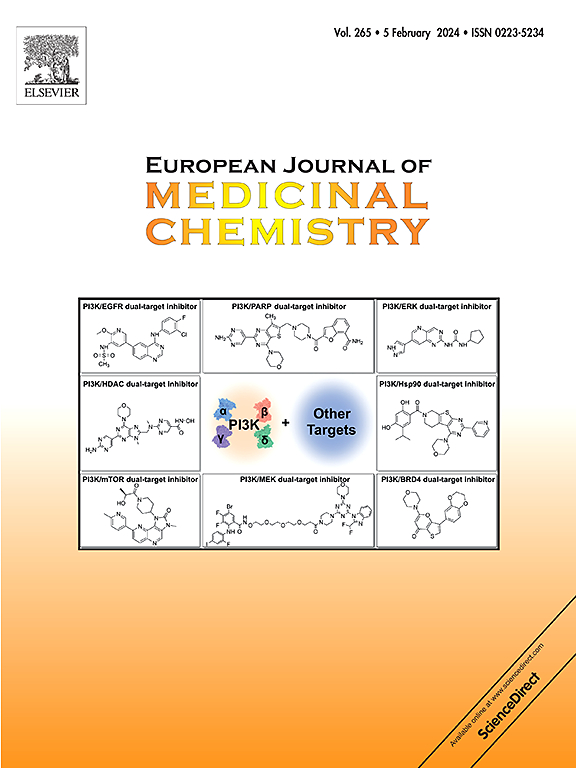The synthesis, photophysical and biological properties of 5,10,15,20-tetra(4-substituted phenyl)tetrabenzoporphyrin derivatives
IF 6
2区 医学
Q1 CHEMISTRY, MEDICINAL
引用次数: 0
Abstract
Photodynamic therapy (PDT) had garnered considerable focus owing to its high photoactivation efficacy and low systemic toxicity. The performance of PDT heavily relied on the behavior of photosensitizers. In this study, a series of new 5,10,15,20-tetra(4-substituted phenyl)tetrabenzoporphyrin derivatives were prepared and their antitumor effects in vitro and in vivo were evaluated. These new compounds presented an absorption peak at ∼700 nm within the phototherapeutic window (600–760 nm). Their effective ROS generation capacities were predominantly verified via the type II mechanism during the irradiation process. In vitro experiments displayed that all compounds exhibited notable phototoxicity with low dark toxicity (IC50 > 76 μM) toward Eca-109 cells. Among them, VI showed obvious photoactivation with a cell survival rate reduction to 7 % at a concentration of 10 μM after exposure to 650 nm laser light (12 J/cm2). In vivo studies revealed that VI had significant antitumor effects with inhibition rate up to 94 %. Subcellular experiments demonstrated that VI distributed mainly in mitochondria, lysosomes and partially in endoplasmic reticulum. Thus, compound VI, which possessed long-wavelength and multi-wavelength absorption capabilities, high photocytotoxicity and low dark toxicity to tumor, would emerge as a promising photosensitizer for individual photo-diagnosis and photodynamic therapy.


5,10,15,20-四(4-取代苯基)四苯并卟啉衍生物的合成、光物理和生物学特性
光动力疗法(PDT)因其高的光激活效率和低的全身毒性而受到广泛关注。PDT的性能在很大程度上取决于光敏剂的性能。本研究制备了一系列新的5,10,15,20-四(4-取代苯基)四苯并卟啉衍生物,并对其体外和体内抗肿瘤作用进行了评价。这些新化合物在光疗窗口(600-760 nm)的~ 700 nm处出现吸收峰。在辐照过程中,它们的有效ROS生成能力主要通过II型机制得到验证。体外实验表明,所有化合物均表现出明显的光毒性和较低的暗毒性(IC50 >;76 μM)对Eca-109细胞的作用。其中,VI在650 nm (12 J/cm2)激光照射浓度为10 μM时表现出明显的光活化作用,细胞存活率降至7%。体内研究表明,VI具有显著的抗肿瘤作用,抑制率高达94%。亚细胞实验表明,VI主要分布于线粒体、溶酶体,部分分布于内质网。因此,具有长波长和多波长吸收能力,对肿瘤具有高光细胞毒性和低暗毒性的化合物VI将成为一种有前景的光敏剂,用于个体光诊断和光动力治疗。
本文章由计算机程序翻译,如有差异,请以英文原文为准。
求助全文
约1分钟内获得全文
求助全文
来源期刊
CiteScore
11.70
自引率
9.00%
发文量
863
审稿时长
29 days
期刊介绍:
The European Journal of Medicinal Chemistry is a global journal that publishes studies on all aspects of medicinal chemistry. It provides a medium for publication of original papers and also welcomes critical review papers.
A typical paper would report on the organic synthesis, characterization and pharmacological evaluation of compounds. Other topics of interest are drug design, QSAR, molecular modeling, drug-receptor interactions, molecular aspects of drug metabolism, prodrug synthesis and drug targeting. The journal expects manuscripts to present the rational for a study, provide insight into the design of compounds or understanding of mechanism, or clarify the targets.

 求助内容:
求助内容: 应助结果提醒方式:
应助结果提醒方式:


